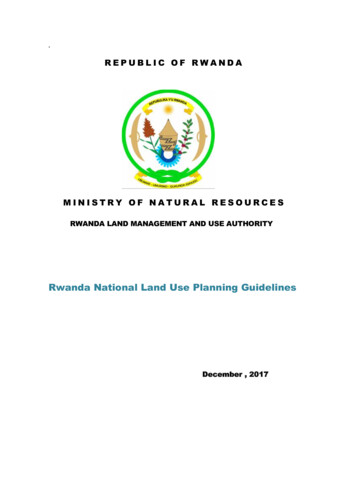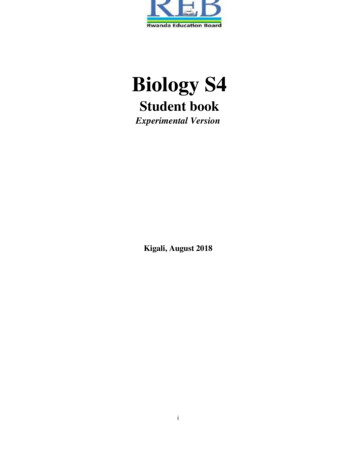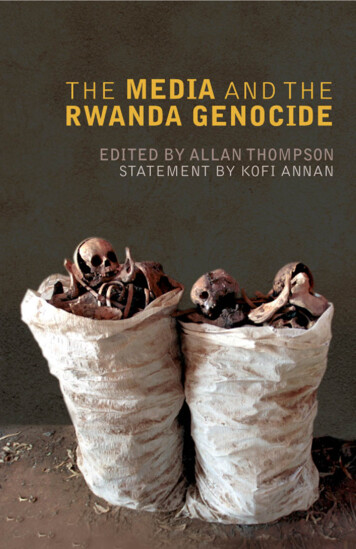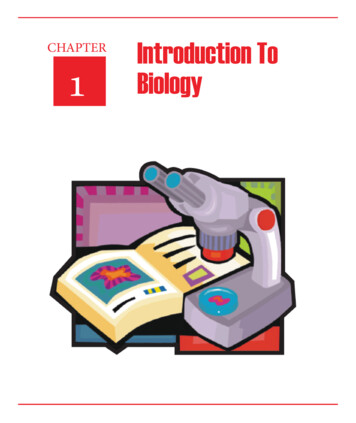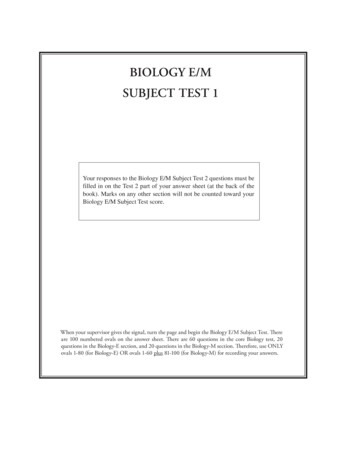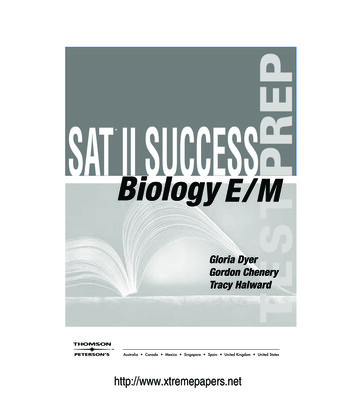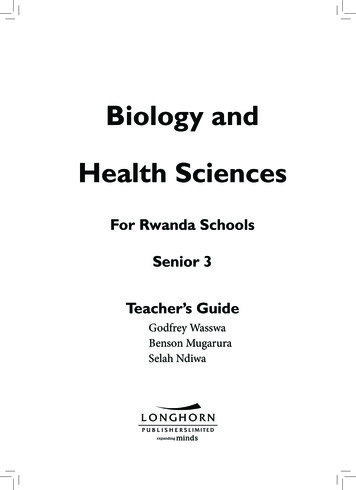
Transcription
Biology andHealth SciencesFor Rwanda SchoolsSenior 3Teacher’s GuideGodfrey WasswaBenson MugaruraSelah Ndiwa
Published byLonghorn Publishers (Rwanda) Ltd166 KG 13 off KG 11 AvenueP.O. Box 5910Kigali, RwandaLonghorn Publishers (Kenya) Ltd.,Funzi Road, Industrial Area,P. O. Box 18033-00500Nairobi, KenyaLonghorn Publishers (Uganda) Ltd.,Kanjokya Street,Plot 74, Kamwokya.P. O. Box 24745Kampala, UgandaLonghorn Publishers (Tanzania) Ltd.,New Bagamoyo/Garden RoadMikocheni B, Plot No. MKC/MCB/81,P. O. Box 1237,Dar es Salaam, Tanzania. G. Wasswa, B. Mugarura, S. Ndiwa, 2017The moral rights of the authors have been asserted.All rights reserved. No part of this publication may be reproduced, stored in a retrievalsystem or transmitted in any form or by any means, electronic, mechanical, photocopying,recording or otherwise without the prior written permission of the publisher.First published 2017ISBN 978 9997 74 795 2AcknowledgementsThe publisher would like to thank Nematex Graphics, James Mugo, Hilary Njathi andOlivier B. Muhizi for design work, generating the illustrations and providing photographsused in this publication. Acknowledgements inadvertently left out are regretted and will bedone in subsequent editions following notification of such omission.Printed by Ramco Printing Works Ltd,Unit 2, Ramco Industrial Complex,Before Imara Daima Turn off, Mombasa Road,P. O. Box 27750 - 00506, Nairobi, Kenya.
ContentsPart 1:Introduction . vSection 1: General introduction . vi1.1 Background information on new curriculum.vi1.2 Rationale of teaching and learning Biology.vi1.3 Types of competences and their acquisition.vii1.4 Cross-cutting issues to be adressed during learning.ix1.5 Special needs education and inclusivity.xii1.6 Classroom organisation . xiii1.7 Safety in the classroom . xv1.8 Assessment and evaluation methods . xviSection 2: Content map. xxSection 3: Lesson plan. xxxvii3.1 Important sub – headings of a lesson plan.xxxvii3.2 Sample lesson plan.xxxixPart II: Unit sections .1Unit 1: Interdependence among organisms in an ecosystem.3Unit 2: Population size. 15Unit 3: Nutrients cycle. 29Unit 4: Effects of human activities on ecosystem I. 42Unit 5: Effects of human activities on ecosystem II . 62Unit 6: Mitosis and Meiosis. 89Unit 7: Heterotrophic nutrition . 106Unit 8: Circulatory system in humans. 128Unit 9: Cellular respiration. 151Unit 10: Skin and homeostatic mechanisms. 163Unit 11: Response and coordination in plants. 178Unit 12: Response and coordination in animals . 188Unit 13: Asexual and sexual reproduction . 216Unit 14: Sexual reproduction in flowering plants. 234Unit 15: Sexual reproduction in human beings. 255iii
Unit 16: Social factors that affect good health . 279Unit 17: Decision-making regarding sexual relationships .293Unit 18: HIV and AIDS (stigma, treatment, care and support) .304Unit 19: Sexual behaviour and sexual responses. 318Unit 20: Genetics. 328Unit 21: Gene Technology . 349Unit 22: Variation and adaptive features. 362Unit 23: Natural and artificial selection . 376iv
PART 1INTRODUCTIONv
SECTION1GENERAL INTRODUCTIONThis teacher’s guide is presented in twoparts. Part I and Part II.This is the generalintroduction part detailing pedagogicalissues. It is divided into three sections: Section 1 – is the general informationSection 2 – is the content map Section 3 – is the sample lesson plan Key words in the unit – a list ofnew words or vocabularies and theirmeanings. Guidance on the problemstatement: A brief statement on howthe teacher should introduce the unitand create a problem situation forlearners to brainstorm and predictwhat the unit is about.1.1 Background informationon new curriculumThe goal to develop a competencebased society, the globalisation process,and particularly the growth of the worldmarket and competition at the global level,as well as a shift from knowledge-based tocompetence-based curriculum necessitateda comprehensive review of the nationalcurriculum to address the required skills inthe Rwandan education system.It is against this background that the REBsyllabus at secondary level was reviewedto ensure that the syllabus is responsive tothe needs of the learner with a shift fromknowledge-based learning to competence-vibased learning.Competence-based learning refers tosystems of instruction, assessment, grading,and academic reporting that are based onstudents demonstrating that they haveacquired and learned the prerequisiteknowledge, skills and attitudes as theyprogress through their education. Apartfrom being integrative, the newly revisedsyllabus guides the interaction betweenthe teacher and the learner in the learningprocess. It further puts greater emphasis onskills a learner should acquire during eachunit of learning. As a competence-basedsyllabus, it elaborates on the three aspectsof knowledge, skills and attitudes andvalues in Biology.1.2 Rationale of teachingand learning BiologyBiology is one of the natural sciencesubjects and is an important disciplinethat has contributed significantly to theglobal environment. Biologists are at theforefront of genetic engineering and healthtransformation and a number of majordevelopments in these areas are due todiscoveries of biologists. The work ofbiologists has led to new technologies inthe production of small scale and industrialproducts that are beneficial to man and theenvironment. Application of the knowledgeof biology is evident in medicine, pharmacy,agriculture, fisheries and food processing
industries. In particular, biology has playeda role in the harmonisation of man’s needswith the conversation of nature and theenvironment.Biology plays a role in the Rwandan ambitionto: Develop a competence – based society. Promote science and technologycompetitiveness in regional and globaljob markets. Address the issues of lack of appropriateskills in the Rwandan education system.Biology is a worthwhile subject becauseit prepares students for the real worldof work through career pathways suchas medicine, agriculture, pharmacy, foodscience, environmental studies and manyothers. Biology provides skills that guidethe construction of theories and lawsthat help to explain natural phenomenonand manage man and the environment. Itprovides answers for the problems facedby our mordern society by empoweringstudents to be creative, innovative and to useindependent approaches to solve problemsin unfamiliar situations.1.3 Types of competencesand their acquisitionCompetences are statements of thecharacteristics that students shoulddemonstrate which indicate they areprepared and have the ability to performindependently in professional practice.The two types of competences envisagedin this curriculum are basic and genericcompetences.objectives highlighted year on year basis andin each of the units of learning.They include:(i) Reading a variety of texts accuratelyand quickly. Expressing ideas, messages and eventsthrough writing legible texts in goodhand-writing with correctly spelt words. Communicating ideas effectively throughspeaking using correct phonetics ofwords. Listening carefully for understanding andseeking clarification when necessary.(ii) Numeracy Computing accurately using the fourmathematical operations. Manipulating numbers, mathematicalsymbols, quantities, shapes and figures toaccomplish a task involving calculations,measurements and estimations. Use numerical patterns and relationshipsto solve problems related to everydayactivities like commercial context andfinancial management. Interpreting basic statistical data usingtables, diagrams, charts and graphs.(iii) Citizenship and nationalidentity Relating the impact of historical eventson past and present national and culturalidentity. Understanding the historical and culturalroots of Rwandan society and how thelocal infrastructure functions in relation(a) Basic competencesBasic competences are addressed in thestated broad subject competences and inLiteracyvii
to the global environment.Demonstrating respect for culturalidentities and expressing the role of thenational language in social and culturalcontext. Advocating for the historical, culturaland geographical heritage of the nationwithin the global dimension. Showing national consciousness, a strongsense of belonging and patriotic spirit. Advocating for a harmonious andc o h e s i ve s o c i e t y a n d wo r k i n gwith people from diverse culturalbackgrounds.(iv) Entrepreneurship andbusiness development Applying entrepreneurial attitudesand approaches to challenges andopportunities in school and in life.Understanding the obligations of thedifferent parties involved in employment.Planning and managing micro projectsand small and medium enterprises.Creation of employment and keepingproper books of accounts.Risk-taking in business ventures and inother initiatives.Evaluating resources needed for abusiness.(b) Generic competencesThe generic competences are competencesthat must be emphasized and reflectedin the learning process. They are brieflydescribed below and teachers must ensurethat learners are engaged in tasks that helpthem to acquire these competences.viii(i)Critical thinking andproblem-solving skillsThe acquisition of such skills will helplearners to think imaginatively, innovativelyand broadly and be able to evaluate and findsolutions to problems encountered in theirsurroundings.(ii) Creativity and innovationThe acquisition of such skills will helplearners to take initiatives and useimagination beyond knowledge providedin classroom to generate new ideas andconstruct new concepts.(iii) Research skillsThis will help learners to find answers toquestions based on existing information andconcepts and use it to explain phenomenafrom gathered information.(iv) Communication in officiallanguagesTeachers, irrespective of being languageteachers’ should ensure the proper useof the language of instruction by learnerswhich is English. The teachers shouldcommunicate clearly and confidently andconvey ideas effectively through spokenand written English by applying appropriategrammar and relevant vocabulary.(v) Cooperation, inter - personalmanagement and life skillsThis will help the learner to cooperatein a team in whatever task assigned andto practise positive ethical moral valuesand while respecting rights, feelings andviews of others. Perform practical activitiesrelated to environmental conservation and
protection. Advocate for personal, familyand community health, hygiene and nutritionand responding creatively to a variety ofchallenges encountered in life.(vi) Lifelong learningThe acquisition of such skills will helplearners to update knowledge and skills withminimum external support. The learners willbe able to cope with evolution of knowledgeadvances for personal fulfillment in areasthat are relevant to their improvement anddevelopment.Role of Biology as a subject indeveloping the competencesThe national policy documents based onnational aspirations identified some ‘basicCompetences’ alongside the ‘GenericCompetences’’ that will develop higherorder critical thinking skills and help thestudent to learn Biology and health sciencesfor application in real life. The nature oflearning activities which are mainly inquiryoriented contribute to the achievement ofthose competencies.Through observations,experimentation and presentation ofinformation during the learning process, thelearner will not only develop deductive andinductive skills but also acquire cooperationand communication, critical thinking andproblem-solving skills. This will be realisedwhen learners make presentations leadingto inferences and conclusions at the end oflearning unit. This will be achieved throughgroup works and cooperative learning,which in turn will promote interpersonalrelations and teamwork.The manipulation of apparatus, equipmentand data class experiments and undertakingof project work by learners will involveanalytical and problem-solving skills directedtowards innovation, creativity and researchactivities by learners.The acquired knowledge in learning Biologyshould develop a responsible citizenwho adapts to scientific reasoning andattitudes and develops confidence inreasoning independently. The learnershould show concern of individual attitudes,environmental protection and complywith the scientific method of reasoning.The scientific method should be appliedwith the necessary rigor, intellectualhonesty to promote critical thinking whilesystematically pursuing the line of thought.1.4 Cross-cutting issues to beinfused during learningThese are emerging issues which need tobe incorporated in the learning process.Each of the cross-cutting issues has its ownimportant programme of learning reflectingkey national priorities. This learning isintegrated into the syllabuses of subjectsacross the curriculum rather than each issuehaving a dedicated timetable slot of its own.As a result of this integration, the learningactivities in the units of subjects acrossthe curriculum incorporate all the learningassociated with the cross-cutting issues.Theeight cross-cutting issues are:(a) Peace and Values EducationThe need for Peace and Values Educationin the curriculum is obvious. Peace is clearlyix
critical for society to flourish and for everyindividual to focus on personal achievementand their contribution to the successof the nation. Values education forms akey element of the strategy for ensuringyoung people recognize the importance ofcontributing to society, working for peaceand harmony and being committed toavoiding conflict.(b)Financial EducationFinancial education makes a strongcontribution to the wider aims of education.It makes learning relevant to real lifesituations. It aims at a comprehensivefinancial education program as a preconditionfor achieving financial inclusion targetand improves the financial capability ofRwandans. Financial education has a key roleof not only improving knowledge of personalbut also transforming this knowledge intoaction. It provides the tools for soundmoney management practices on earnings,spending, saving, borrowing and investing.Financial education enables people to takeappropriate financial services both formaland informal that are available to themand encourages financial behaviours thatenhance their overall economic well-being.(c)Standardisation cultureStandardisation culture develops learners’understanding of the importance of standardsas a pillar of economic development and inthe practices, activities and lifestyle of thecitizens. It is intended that the adoptionof standardization culture should have animpact upon health improvement, economicxgrowth, industrialization, trade and generalwelfare of the people. While education isthe foundation and strength of our nation,standards are one of the key pillars ofsustainable economic development.(d) Genocide studiesGenocide studies provides young peoplewith an understanding of the circumstancesleading to the genocide and the remarkablestory of recovery and re-establishingnational unity. Genocide studies helpslearners to comprehend the role of everyindividual in ensuring nothing of the sortever happens again.The intent of a cross-cutting curriculumaround the topic of genocide is to fightagainst genocide, genocide denial, andgenocide ideology; and to equip studentswith a more fundamental and comprehensiveunderstanding of the genocide, therebypreventing further human rights violations inthe future and enabling Rwanda’s populationof young people to more competently andthoughtfully enter the workforce. So, itneeds to be emphasized.(e)Environment andsustainabilityThe growing awareness of the impact ofthe human race on the environment has ledto recognition of the need to ensure ouryoung people understand the importance ofsustainability as they grow up and becomeresponsible for the world around them.Hence Environment and Sustainability is avery important cross-cutting issue. Learnersneed basic knowledge from the natural
sciences, social sciences and humanitiesto understand and interpret principlesof sustainability. They also need skills andattitudes that will enable them in theireveryday life to address the environmentand climate change issue and to have asustainable livelihood.(f)Gender educationThere is a strong moral imperative to affordevery individual their basic human rightsand gender inequality results in womenand girls being treated less favourablythan men. A strongly negative impact ofunequal treatment, which affects the nationas a whole, is the fact that it results inwomen being held back and their talentsand abilities not being fully realised. Witha good understanding of the principles ofGender equality, it is intended that futuregenerations will ensure that the potential ofthe whole population is realised.(g) Comprehensive sexualityeducation (HIV/AIDS,STIs, Family planning andreproductive health)Comprehensive sexuality education, whichis age-appropriate, gender-sensitive and lifeskills-based can provide young people withthe knowledge and skills to make informeddecisions about their sexuality and life style.Preparing young people for the transitionto adulthood has been one of humanity’sgreatest challenges with human sexualityand relationships at its core. Few youngpeople receive adequate preparationsfor their sexual lives. This leaves thempotentially vulnerable to coercion, abuseand exploitation unintended pregnancyand sexually transmitted infections (STIs)including HIV/AIDS. Many young peopleapproach adulthood faced with conflictingand confusing messages about sexualityand gender. This is often exacerbated byembarrassment, silence, disapproval andopen discussion of sexual matters by adults(parents, teachers) at the very time when itis most needed.Comprehensive sexuality educationsupports a rights - based approach inwhich values such as respect, acceptancetolerance, equality, empathy and reciprocityare inextricably linked to universally agreedhuman rights. A clear message concerningthese dangers and how they can be avoided,from right across the curriculum, is the bestway to ensure that young people understandthe risks and know how to stay healthy.(h)Inclusive EducationInclusive education involves ensuring alllearners are engaged in education and thatthey are welcomed by other students sothat everyone can achieve their potential.Inclusive practice embraces every individualregardless of gender or ability including thosewith learning difficulties and disabilities.The most focus of inclusive curriculum ison ensuring participation in education oflearners with different learning styles andother difficulties. To be successful, it entailsa range of issues including teacher’s positiveattitudes, adapting the learning resources,differentiation of teaching and learningmethods and working together. Overall, thebenefits of an inclusive curriculum extendto all learners.xi
1.5 Special needs educationand inclusivityAll Rwandans have the right to accesseducation regardless of their different needs.The underpinnings of this provision wouldnaturally hold that all citizens benefit fromthe same menu of educational programs.The possibility of this assumption is thefocus of special needs education.The criticalissue is that we have persons/ learners whoare totally different in their ways of livingand learning as opposed to the majority.Thedifference can either be emotional, physical,sensory and intellectual learning challengestraditionally known as mental retardation.These learners equally have the right tobenefit from the free and compulsorybasic education in the nearby ordinary/mainstream schools.Therefore, the schools’role is to enrol them and also set strategiesto provide relevant education to them.Theteacher therefore is requested to considereach learner’s needs during the teachingand learning process. Assessment strategiesand conditions should also be standardisedto the needs of these learners. Also, ensurethat you include learners with specialeducational needs in classroom activitiesas much as possible.The special needs learners can fall in any ofthe following common categories: Physical difficulties Visual difficulties Hearing difficulties Intellectual difficulties Emotional disordersThe teacher should identify such casesxiiand help facilitate the affected learners’learning. For example, learners’ withvisual and hearing difficulties shouldsit near the teacher’s table for easysupervision and assistance.The followingare some suggestions on how to supportspecial needs children in your class.(a) Learners with physicaldifficultiesIn this group of learners, the affectedareas are normally some body parts,especially the limbs. There may bepartial or total loss of use of the limbs.In case the legs are affected, the learnerswill need assistance during activities thatinvolve movement.This could be duringa nature walk and other activities thatlearners have to stand for some reason.The teacher should organize for thelearners’ ease of movement around.The learner should also be given timeto catch up with the others.In case the hands are affected, thelearners should be given more timeto finish their work. In both cases, thelearners should not be pressurized to dothings that can cause injury or ridicule.(b) Learners with visualdifficultiesThese learners normally have problemswith their eyesight. They should sit ina position where they are able to seethe chalkboard without straining. Suchlearners could be longsighted or shortsighted.The material to be observed should
be brought closer to the learner and amagnifying lense used where necessary. Theteacher should use large diagrams, chartsand labels. In some cases, the learners canbe allowed to touch and feel whatever theyare looking at. Other learners can assist byreading aloud. The lighting system in theclassroom can also be improved.The teacher should read aloud most of thethings he/she writes on the chalkboard.(c) Learners with hearingdifficultiesThe affected part in this case is the ear.The learner should have hearing aids.The teacher should use as many visualaids as possible. They should also projecttheir voice and always talk while facing thelearners. Use of gestures and signs whiletalking helps the learner figure out whatthe teacher is saying as well.(d) Learners with speechdifficultiesA common example in a normal class is thestammerer. They always speak with a lotof difficulties.The teacher should be patientwith them and encourage such learners toexpress themselves in their own way. Suchlearners should be given more writtenexercises.(e) Learners with intellectualdifficultiesThe teacher should try to identify thenature and level of the mental difficulty.Learners with mental difficulties should thenbe given special assistance and attentionat an individual level. They can be givenspecial tests or assessments. In general,all the learners with difficulties should bereinforced promptly. This encourages andmotivates them.The teacher and the rest ofthe class should never ridicule learners withany of the difficulties. Note that generally,people with any kind of disability can be verysensitive to any kind of negative commentsor criticism.Remind them that ‘Disability is notinability’.The teacher should avoid giving privilegeswhere the learners do not deserve them.Treat them fairly but not with undue favours.(f)Learners with emotionaldisordersThese are learners who get annoyedeasily either because of past experiencesor it may be just their nature. The teachershould handle this category of learnerswith care and caution other learnersagainst mishandling them.1.6 Classroom organisationA well organised classroom is an asset togood Biology teaching but there is no onecorrect style to suit all classrooms andsituations. However, the teacher shouldconsider the following factors whenorganising the classroom:xiii
(a) Furniture should be well arranged soas to allow free movement of learnersand the teacher.shape of letter ‘u’ such that each learnercan see what the teacher is doing clearlyand without obstruction or pushing.(b) Set a corner for storing materials soas not to obstruct learners or distractthem.Grouping learners for learning(c) The number of learners in the class andtheir ages.(d) Learners should be reasonably spreadout so that they do not interfere withone another’s activities.(e) The series of lessons or activities goingon for a number of days or weeks suchas individual or group work or wholeclass.Most of the Biology activities are carried outin groups and therefore the teacher shouldplace 2 or 3 desks against each other andthen have a group of learners sitting aroundthose desks.If the learners are involved in individualwork, each learner can work on the flooror on the desk or a portion of the desk ifthey are sharing. In this case, they need notface each other.Grouping learners for learning hasincreasingly become popular in recent years.In fact, the shift from knowledge based tocompetence-based curriculum will makegrouping the norm in the teaching process.Grouping learners can be informed by oneor all of the followingFig. 1.1 Sample classroom arrangement(a) Similar ability grouping.(f) Classroom itself, that is, positions ofwindows, doors such that learners facethe lighted areas of the room.(b) Mixed ability grouping.(g) Personal preferences. But theseshould be in the interest of thelearners especially where the teachernormally stand; the teacher should beable to communicate with all learners,and also have a general view of alllearners in the class.(e) Friendship groupingIn certain lessons, the teacher may wish tocarry out a demonstration. In this case, thelearners should be sitting or standing in asemicircle, or arranged around an emptyxiv(c) Similar interests grouping(d) Needs grouping(f) Sex groupingIn Biology, groupings are commonly those oftypes (a), (b), (c) and (d). Grouping learnershas several advantages such as:(a) The individual learner’s progress andneeds can easily be observed.(b) The teacher-learner relationship isenhanced.(c) A teacher can easily attend to the needsand problems of a small group.
(d) Materials that were inadequate forindividual work can now easily beshared.(e) Learners can learn from one another.(f) Cooperation among learners can easilybe developed.(g) Many learners accept correction fromthe teacher more readily and withoutfeeling humiliated when they are in asmall group rather than the whole class.(h) Learners’ creativity, responsibility andleadership skills can easily be developed.(i) Learners can work at their own pace.The type of “grouping” that a teachermay choose depends on:(a) The topic or task to be tackled.(b) The materials available.(c) Ability of learners in the class.Fig. 1.2 Sample classroom groupingHowever, the teacher must be flexibleenough to adjust or change his/her type ofgrouping to cope with new situations.There is no fixed number of learnersthat a group must have. This again will bedictated by such factors as the task to bedone, the material available, characteristicsof learners in your class, size and thespace available. However, groups shouldon average have between four to sevenlearners. You can also resort to pairworkdepending on the nature of the contentbeing taught at the time.Note:There is no one method or approach toteaching that is appropriate to all lessons.A teacher should, therefore, choose wiselythe method to use or a combination ofmethods depending on the nature of thetopic or subtopic at hand.1.7 Safety in the classroomLearners in secondary school are extremelyactive and curious.As such, they are inclinedto getting harmed and injured. They shouldtherefore be constantly protected fromsources of injury and harm. The teacheris therefore advised to take strict s
Biology plays a role in the Rwandan ambition to: Develop a competence - based society. Promote science and technology competitiveness in regional and global job markets. Address the issues of lack of appropriate skills in the Rwandan education system. Biology is a worthwhile subject because it prepares students for the real world
